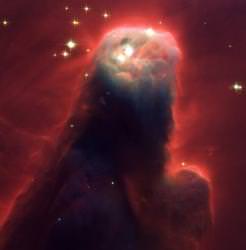It’s amazing to think that the Sun and planets formed out of a diffuse cloud of gas and dust. Somehow, the dust clung together into larger and larger particles – grains of sand. This sand then went on to become pebbles, rocks, and eventually entire planets. Well now astronomers have discovered a young star system with a disk of sand-sized particles orbiting it.
The discovery was made by Christopher Johns-Krull, assistant professor of physics and astronomy at Rice University, working with collaborators in the US, Germany, and Uzbekistan.
Astronomers have detected microscopic dust particles orbiting other stars before, but only by sensing their infrared emissions. This method isn’t precise enough to tell astronomers how big these particles become, or how far they’re orbiting from the newly forming star.
In this new study, the researchers measured the light reflected from sand orbiting a binary system called KH-15D. The stars are about 2,400 light years from Earth in the Cone nebula, and they’re a mere 3 million years old.
The researchers discovered that the Earth has a nearly edge-on view of KH-15D. From our point of view, the dusty disk mostly blocks the stars from view, but one star has an eccentric orbit that occasionally peeks up above the disk.
“We were attracted to this system because it appears bright and dim at different times, which is odd. These eclipses let us study the system with the star there and with the star effectively not there,” Johns-Krull said. “It’s a very fortuitous arrangement because when the star is there all the time, it’s so bright that we can’t see the sand.”
The team examined 12 years of data gathered by a handful of observatories around the world, and studied how light from the star was being reflected by the disk. They were able to determine the chemical composition and size of the sand-like particles.
Original Source: Rice University News Release


This is a fantastic discovery. Any evidence which supports popular theory is certainly a good thing when it comes to our growing understanding of the universe. We’re on the right track…
http://www.spaceref.com/news/viewpr.html?pid=24964
Is this the same story, with different actors?
If yes, good mileage!
What would the spectrum of “sand” look like?
Sand is dense, what would cause tiny dust/molecular particles to fuse to something that heavy in a weightless environment? Not the long winded scientific process please…
“They were able to determine the chemical composition and size of the sand-like particles.”
Well……..?
That’s how it ends?
Come on, the whole point of the story is that now they can figure that out, and that they *have* figured that out for this system. Why not just tell us? It would take 2 more sentences.
Wow. For once a story based on observations! And a picture that’s a photograph instead of an artist’s conception! You guys are starting to take all the fun out of cosmology. And now the major prize: Anyone who can directly image an actual planet, especially an earth type “M”.